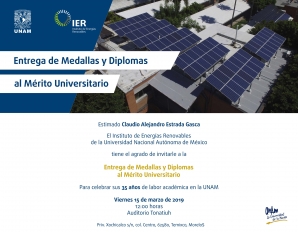H.I. Villafán-Vidales, S. Abanades, M. Montiel-González, H. Romero-Paredes, C.A. Arancibia-Bulnes, C.A. Estrada.
Abstract
A 1 kWth cavity-type solar reactor devoted to the thermal reduction of volatile oxides as part of a two-step thermochemical cycle is analyzed numerically. The thermochemical reactor consists of a vertical-axis cavity-type receiver in which the reactant is injected from the bottom in the form of an ascending rod made of a stack of zinc oxide compressed pellets undergoing thermal dissociation. A transient heat transfer model allows the simulation of the thermal behavior under real conditions for the rod of reacting particles exposed to concentrated solar radiation. The developed numerical model couples radiation, conduction and convection heat transfers to the kinetic of the reaction. The incident solar irradiation on the reactant surface is obtained using the Monte-Carlo ray tracing technique applied first to the solar concentrator and second to the reactor cavity. The model is used to predict the temperature profile from the irradiated front surface of the compressed reactant, the evolution of outlet oxygen molar flow-rate during the reduction reaction and the instantaneous thermochemical efficiency, as a function of time. The calculated results are compared with the experimentally obtained data. The agreement between experimental data and simulation related to both the temperature and the oxygen progress is fairly good with Ea = 380 kJ mol−1 and k0 = 246 × 106 mol m−2 s−1 for the kinetics of the ZnO dissociation reaction.

